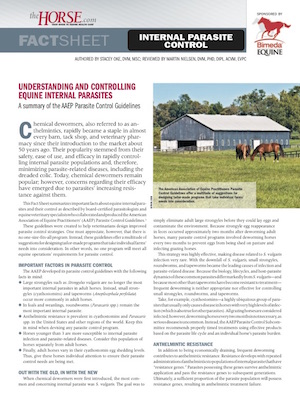By Stacey Oke, DVM, MSc | Mar 8, 2018
 Chemical dewormers, also referred to as anthelmintics, rapidly became a staple in almost every barn, tack shop, and veterinary pharmacy since their introduction to the market about 50 years ago. Their popularity stemmed from their safety, ease of use, and efficacy in rapidly controlling internal parasite populations and, therefore, minimizing parasite-related diseases, including the dreaded colic. Today, chemical dewormers remain popular; however, concerns regarding their efficacy have emerged due to parasites’ increasing resistance against them.
Chemical dewormers, also referred to as anthelmintics, rapidly became a staple in almost every barn, tack shop, and veterinary pharmacy since their introduction to the market about 50 years ago. Their popularity stemmed from their safety, ease of use, and efficacy in rapidly controlling internal parasite populations and, therefore, minimizing parasite-related diseases, including the dreaded colic. Today, chemical dewormers remain popular; however, concerns regarding their efficacy have emerged due to parasites’ increasing resistance against them.
This Fact Sheet summarizes important facts about equine internal parasites and their control as described by board-certified parasitologists and equine veterinary specialists who collaborated and produced the American Association of Equine Practitioners’ (AAEP) Parasite Control Guidelines.
Supporting Documentation
Abstract - Diagnosis and control of anthelmintic-resistant Parascaris equorum
Evidence of Ivermectin Resistance by Parascaris equorum on a Texas Horse Farm

